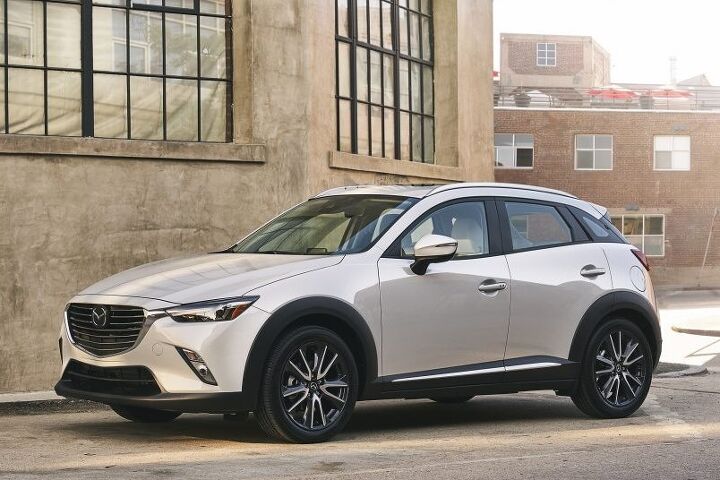2018 Mazda CX-3 Is Better, But Until It's Bigger, Better Probably Isn't Good Enough
Accompanied by a modest price increase of $150, Mazda’s first-generation CX-3 undergoes numerous under-the-skin updates for the subcompact crossover’s third model year.
Mazda’s Smart City Brake Support is now standard across all 2018 CX-3s. G-Vectoring Control, a nifty piece of software that sharpens steering response while reducing driver effort, is also standard on every 2018 Mazda CX-3. Mid-grade CX-3 Tourings are now equipped with auto headlights, auto climate control, and rain-sensing wipers.
Thicker glass, more sound deadening, and improved door seals bolster every CX-3’s refinement quotient. Mazda has also altered the suspension tuning of all CX-3s for the 2018 model year. Mazda claims revised bushings, new front lower control arms, recalibrated dampers, and new engine mounts will improve the CX-3’s “already class-leading chassis dynamics.”
Mazda’s probably not wrong. The 2016-2017 CX-3 was an exceptionally pleasing subcompact crossover to drive. And on that particular subject — on-road behavior — we’re apt to trust Mazda when the company says the refreshed model will be even better. But this is just a refresh, and an invisible refresh at that. As a result, the Mazda CX-3 has the same limitations for MY2018 that it had before, the kind of limitations that severely cramp demand.
It’s very small.
To be fair, the CX-3 is supposed to be small. Serving as a Mazda’s entry in the subcompact crossover sector led by the Jeep Renegade, GM’s Gamma II twins (Encore and Trax), and Honda’s HR-V, the Mazda CX-3 also effectively replaced the Mazda 2 subcompact, which Mazda discontinued in the U.S. marketplace. (The 2011-2014 2 hatchback’s successor can now be purchased in sedan form as the Toyota Yaris iA.)
Yet while there are clearly some customers who tolerate the CX-3’s tiny dimensions — and I would be one of them if I was a subcompact crossover buyer — the CX-3 is really only supposed to be small on the outside.
Honda offers 24.3 cubic feet of cargo capacity behind the rear seats of its HR-V, for example. The CX-3 offers half that much. Besides the HR-V’s more flexible flipping/folding/standing Magic Seat second row, there’s also 14-percent more total volume for passengers and four inches of extra rear legroom.
Sometimes, official manufacturer measurements don’t tell the whole story. But Mazda’s numbers aren’t kidding around. Despite exterior dimensions that basically mirror competitors, the CX-3 is a decidedly cramped subcompact crossover, and Mazda pays the price for the car’s poor packaging.
Only 2.9 percent of the subcompact crossovers sold in America during the first seven months of 2017 were Mazda CX-3s. That’s down from 3.7 percent a year ago, a loss of market share caused by the category’s growth — sales are up 6 percent this year — and the CX-3’s rapid decline. Year-to-date, Mazda CX-3 sales plunged 17 percent, a loss of more than 1,900 sales for a model that already lacked any form of popularity. Year-over-year, CX-3 sales have declined in eight consecutive months. Precisely two years into its tenure, the Mazda CX-3 has never managed to produce 1,800 monthly sales, topping out at 1,748 units in March 2016.
There is good news. Mazda recognized some of the CX-3’s outstanding issues — NVH and ride quality — and worked to remedy them for MY2018. Mazda has also been pleased in the past with the number of high-priced CX-3s the company sells.
But until Mazda can solve the CX-3’s packaging faux pas on a next-gen platform, the CX-3 won’t make any meaningful headway in the U.S. market. Or it’ll be worse than that, and the CX-3 will continue to rapidly lose ground.
The 2018 Mazda CX-3 is priced from $21,050, including destination. All-wheel drive is a $1,250 option. With optional paint, the top-trim 2018 CX-3 Grand Touring AWD with the GT Premium Package costs $29,090.
[Images: Mazda]
Timothy Cain is a contributing analyst at The Truth About Cars and Autofocus.ca and the founder and former editor of GoodCarBadCar.net. Follow on Twitter @timcaincars.
More by Timothy Cain
Latest Car Reviews
Read moreLatest Product Reviews
Read moreRecent Comments
- ToolGuy The only way this makes sense to me (still looking) is if it is tied to the realization that they have a capital issue (cash crunch) which is getting in the way of their plans.
- Jeff I do think this is a good thing. Teaching salespeople how to interact with the customer and teaching them some of the features and technical stuff of the vehicles is important.
- MKizzy If Tesla stops maintaining and expanding the Superchargers at current levels, imagine the chaos as more EV owners with high expectations visit crowded and no longer reliable Superchargers.It feels like at this point, Musk is nearly bored enough with Tesla and EVs in general to literally take his ball and going home.
- Incog99 I bought a brand new 4 on the floor 240SX coupe in 1989 in pearl green. I drove it almost 200k miles, put in a killer sound system and never wish I sold it. I graduated to an Infiniti Q45 next and that tank was amazing.
- CanadaCraig As an aside... you are so incredibly vulnerable as you're sitting there WAITING for you EV to charge. It freaks me out.



































Comments
Join the conversation
CX-3 is poor man's Mini Cooper to me! CX-3 does not have the performance however! Mazda needs to put in the 2.5 Turbo engine for it to be competitive with the Mini!
Don't be daft. There's a CX-5 for the fysically challenged.